Velvet fabric is one of the most luxurious materials around. Its smooth, tactile surface instantly adds a touch of sophistication and class to any outfit or piece of furniture. However, it can be very delicate, requiring special care and attention when cleaning and maintaining its plush texture.
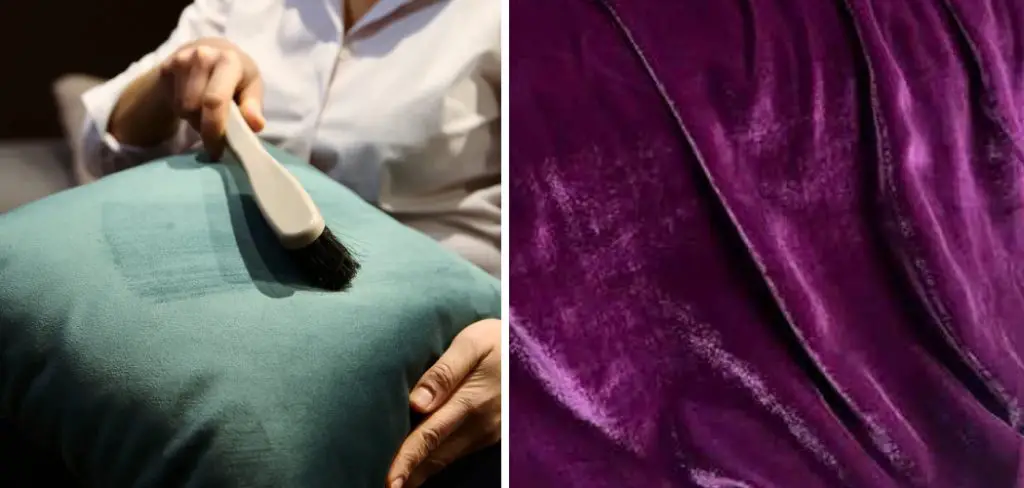
If you are willing to put in some extra effort then velvet fabric can last for years with a beautiful shine that puts other fabrics to shame! Fortunately, we’re here today to help you learn how to fix velvet fabric with easy tips and tricks so you can keep your favorite pieces looking new no matter what life throws at them.
Tools and Materials You Will Need to Fix Velvet Fabric
- Iron
- Hairdryer
- Clean white cloth or towel
- Fine-bristled brush (preferably a velvet brush)
- Velvet fabric patch or piece of scrap velvet (optional)
Step-by-step Guidelines on How to Fix Velvet Fabric
Step 1: Identify the Type of Velvet Fabric
Before you start any repairs, it’s important to know what type of velvet fabric you are working with. There are various types such as silk velvet, cotton velvet, and synthetic velvet, each requiring different methods for cleaning and fixing.
If possible, check the tag or label on your fabric to determine its composition. If not, you can try doing a burn test to identify the type of fabric. However, this should be done with caution and only as a last resort.
Step 2: Steam or Iron Out Wrinkles
The first step in fixing velvet fabric is to remove any wrinkles or creases. If the fabric is not too delicate, you can use an iron on low heat or a steamer to gently smooth out wrinkles. Remember to always use a clean white cloth or towel between the iron/steamer and the fabric to prevent any direct heat damage.

Step 3: Remove Stains
Accidents happen and stains are inevitable, especially with velvet fabric. To remove stains, start by blotting the affected area with a clean white cloth or towel. Do not rub the stain as this can cause it to spread and become more difficult to remove. You can also try using a gentle fabric cleaner specifically made for velvet, but make sure to test it on a small inconspicuous area first.
Step 4: Brush Out Crushed Areas
Over time, velvet fabric can become crushed in certain areas, causing the pile to flatten and lose its signature shine. To fix this, use a fine-bristled brush (preferably a velvet brush) to gently fluff up the crushed areas in one direction. Be careful not to brush too hard as this can damage the delicate fibers.
Step 5: Patch Up Holes or Tears
If your velvet fabric has any holes or tears, you can patch them up with a small piece of scrap velvet or a velvet fabric patch. Cut out the shape and size needed to cover the hole/tear and use fabric glue or needle and thread to carefully attach it to the backside of the fabric. While this may not completely hide the damage, it will prevent it from getting worse and prolong the life of your fabric.
Step 6: Use a Hairdryer for Stubborn Areas
For stubborn wrinkles or crushed areas that won’t budge, you can use a hairdryer on low heat to gently warm up the fibers and help them reset. Again, be careful not to hold the hairdryer too close or use it on high heat, as this can damage the fabric. Using a fine-bristled brush at the same time can also help to fluff up the fibers.
Following these simple steps can help you fix velvet fabric and keep it looking beautiful for years to come. Remember to always handle the fabric with care, avoid harsh chemicals and heat, and give it a gentle brush every now and then to maintain its softness and shine.
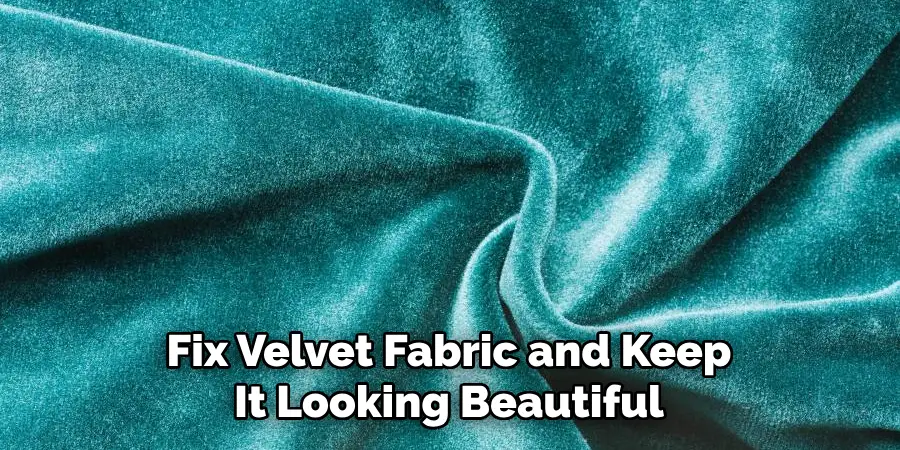
With proper care, your velvet pieces will continue to add that touch of luxury to your wardrobe or home decor for a long time. So, go ahead and enjoy the plushness of velvet without worrying about any damage – you now know how to fix them!
Additional Tips and Tricks to Fix Velvet Fabric
1. When working with velvet fabric, it is important to always use a sewing machine that has a walking foot or roller foot. This will help prevent the fabric from slipping and puckering while sewing.
2. If you are unable to find a sewing machine with the appropriate foot, try using tissue paper or a layer of muslin between the velvet and the presser foot. This will help the fabric move smoothly and prevent any puckering.
3. Always use a new, sharp needle when sewing velvet fabric. A dull needle can cause the fabric to snag or create uneven stitches.
4. Before starting any sewing project with velvet fabric, make sure to test your machine’s tension settings on a scrap piece of fabric. This will help ensure that your stitches are even and prevent any puckering.
5. When cutting velvet fabric, use a sharp pair of scissors and cut along the grain of the fabric. This will help prevent fraying and ensure that your final product has clean edges.
6. To keep your velvet fabric looking fresh and new, avoid using an iron on high heat. Instead, use a steamer or iron on low heat with a pressing cloth. This will help prevent the fabric from becoming shiny or crushed.
7. If your velvet fabric becomes wrinkled, try using a steamer to gently remove the wrinkles. Avoid ironing the fabric directly as this can damage the delicate fibers.

8. When storing velvet fabric, it is best to roll it instead of folding it to avoid any permanent creases or wrinkles.
9. If you accidentally get a stain on your velvet fabric, do not rub it vigorously as this can damage the fibers. Instead, gently dab the stain with a solution of mild detergent and water. Always test the solution on a small, inconspicuous area first.
10. In case of any tears or holes in your velvet fabric, use an adhesive fabric patch or fusible interfacing to repair the damage. Make sure to follow the manufacturer’s instructions and use a pressing cloth when applying heat.
Following these tips and tricks will not only help you fix any issues with your velvet fabric but also ensure that it stays looking beautiful for years to come. Remember to always handle the fabric with care and test new techniques on scrap pieces first before working on your final project. Happy sewing!
Things You Should Consider to Fix Velvet Fabric
1. The first thing you should consider when fixing velvet fabric is the type of stain or damage present on the fabric. Different types of stains require different cleaning methods, so it’s important to identify the issue before proceeding.
2. If there are any loose threads or tears in the fabric, make sure to repair them first before attempting to clean the fabric. This will prevent further damage and ensure a smoother cleaning process.
3. When dealing with stains on velvet fabric, it’s important to act quickly. The longer a stain sits, the harder it will be to remove. Blot the stain gently with a clean cloth or paper towel as soon as possible to prevent it from settling in.
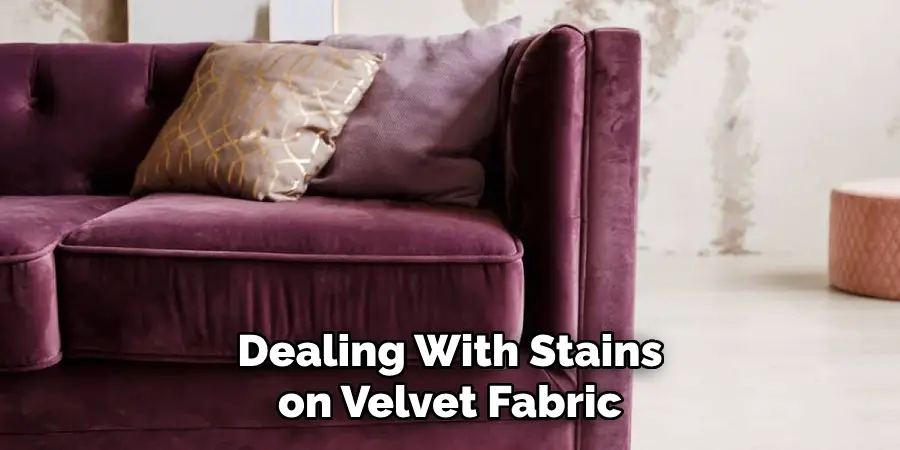
4. Before using any cleaning products on velvet fabric, always test them on a small, inconspicuous area first. This will ensure that the product does not damage or discolor the fabric.
5. If you are dealing with a particularly tough stain, consider using a specialized velvet cleaner or bringing the fabric to a professional cleaner. Using the wrong products or techniques can result in permanent damage to the fabric.
6. When cleaning velvet, it’s important to be gentle and avoid harsh scrubbing or rubbing. Velvet is a delicate fabric and can easily be damaged if not handled carefully.
7. If you are attempting to remove a stain from velvet, work from the outside to prevent the stain from spreading further. Blot the stain gently with a clean cloth and repeat until the stain is fully removed.
8. After cleaning velvet fabric, it’s important to properly dry it to prevent any mold or mildew from forming. Hang the fabric in a well-ventilated area or use a fan to speed up the drying process.
9. When storing velvet fabric, make sure it is completely clean and dry before putting it away. Avoid folding or creasing the fabric as this can cause permanent damage to the fibers. Instead, roll the fabric loosely and store it in a breathable container.
Following these considerations will help you successfully fix velvet fabric and restore it to its original beauty. Remember to always handle the delicate fabric with care and seek professional help if needed for tougher stains or damages. With proper cleaning and maintenance, your velvet fabric will continue to look luxurious and elegant for years to come.
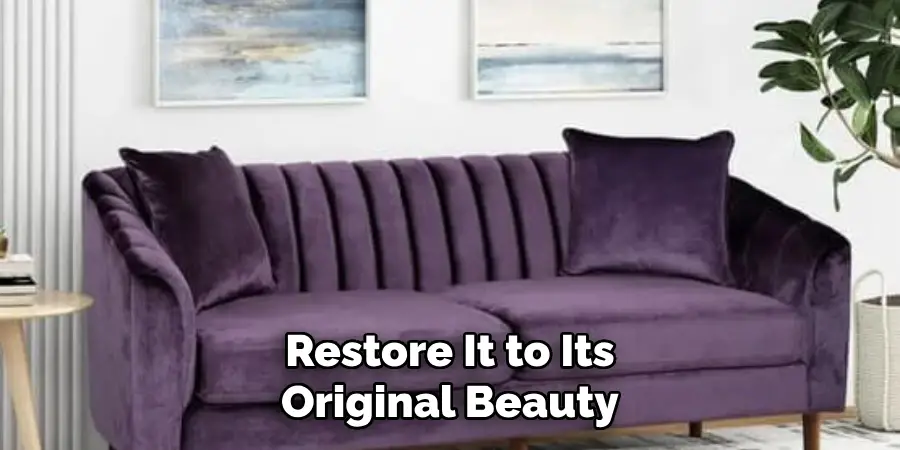
Precautions Need to Be Followed for Fixing Velvet Fabric
1. Before attempting any methods to fix velvet fabric, make sure to read the care instructions on the fabric label. Some velvet fabrics may be labeled as “dry clean only” and require special attention.
2. Avoid using heat when cleaning or drying velvet fabric. High temperatures can cause shrinkage and damage the delicate fibers of the fabric.
3. When dealing with spills or stains on velvet, do not rub the fabric. This can cause the stain to spread and become more difficult to remove.
4. If using a cleaning product, make sure it is specifically formulated for velvet fabric. Using harsh chemicals or bleach can permanently damage the fabric.
5. Always handle velvet fabric with clean hands to prevent oils and dirt from transferring onto the fabric.
6. When repairing tears or loose threads on velvet fabric, use a needle and thread that matches the color of the fabric. This will help camouflage any repairs.
7. If you are unsure about how to fix a particular issue with your velvet fabric, seek advice from professionals or do further research before attempting any methods.
8. Regularly vacuuming or brushing velvet fabric can help prevent dirt and dust from settling into the fibers, keeping it looking clean and fresh.
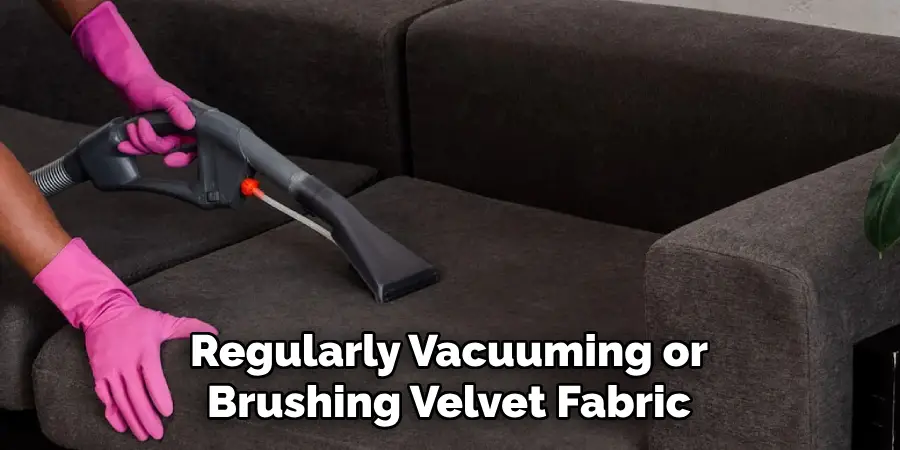
By following these precautions, you can ensure that you handle your velvet fabric with care and prevent any further damage or issues while attempting to fix it. Remember, prevention is always better than cure when it comes to maintaining the beauty of your velvet fabric. So be sure to give your velvet fabric the proper attention it deserves to keep it looking luxurious and elegant for years to come.
Conclusion
Fixing velvet fabric can be a tricky process, and it requires great care in order to have the desired effect. It is important to take time to do it properly so that you can restore the fabric’s beauty once again and be able to use it safely. Thankfully, with the help of these tips and tricks, you now have access to various methods and solutions that will get your velvet back in tip-top shape.
Take some extra time to make sure it’s done right – whether you opt for steam cleaning, spot cleaning, or dry cleaning, find the method that works best for both your fabrics and occasions! Don’t let a ruined piece of velvet ruin your look or day; how to fix velvet fabric is as simple as knowing which method works best for each situation – so put in the effort today and make a huge difference tomorrow.
With all this information at hand, why wait any longer? Try one of these amazing techniques today for velvet fabric perfection!

